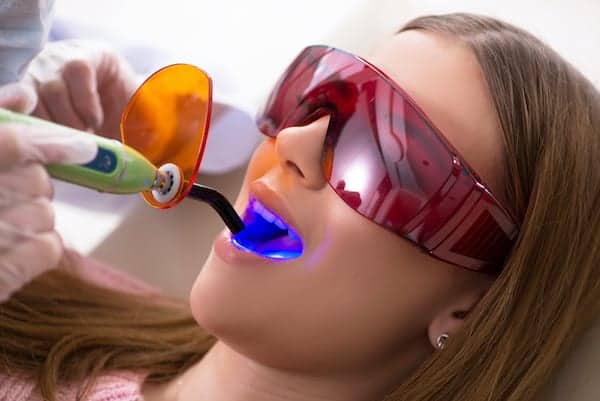At Garden Square Dental we take composite bonding very seriously. Why? Because it’s a minimally invasive technique that preserves the remaining tooth structure and reduces the need for drilling.
- Broken or chipped teeth
- Discoloured or stained teeth
- Gaps between teeth
- Superficial decay
- Sensitive teeth

Broken or chipped teeth
When a tooth becomes broken or chipped as a result of trauma, such as an accidental fall, biting on an olive stone, or teeth grinding, composite bonding is an excellent way of restoring the shape and form of the tooth. The dentist would assess the missing portion of the tooth, then recreate the shape using increments of the composite to re-build the tooth to its former glory.
Click here to find out more about Tooth Erosion
Discoloured or stained teeth
If a tooth has become darkened with age or has an old composite filling that has unsightly stains around its edges, the tooth can be refilled and covered with new composite bonding that will hide the discolouration. It might be worth considering teeth whitening before this process to lighten the teeth before matching the colour of the composite bonding.
Click here to view our teeth whitening gallery
Gaps between teeth
If there are unwanted gaps between teeth occurring naturally or from teeth that have moved, these gaps could potentially be closed with cosmetic bonding. If the gaps are small then they could be closed ‘chairside’ with composite or if the gaps are large then composite veneers could be considered whereby composite material is bonded onto the entire visible surface of the tooth.
Click here to view our Cosmetic Dentistry gallery
Superficial decay
If the tooth has dental decay (rot) then this would need to be removed and filled with composite bonding. Essentially this is a standard filling technique using a cosmetic tooth coloured filling material.
Click here to find out more about Fillings
Sensitive teeth
If teeth have become sensitive due to receding gums or enamel erosion, the tooth can be treated with cosmetic bonding to help relieve the sensitivity and also protect the tooth from further enamel erosion from dietary acid or overzealous tooth brushing.
Click here to find out more about Sensitive Teeth
Composite bonding is a modern, painless approach to repairing or restoring teeth without the need for drilling the tooth or the need for local anaesthetic injections. The results can be as subtle or dramatic as you’d like them to be with the additional benefit of being completely reversible. Composite bonding produces a robust and durable result which can last several years, thus providing a cost-effective alternative to orthodontic treatment or dental veneers. For a consultation with Dr Sofi our cosmetic expert, please call 020 7229 8716 to book an appointment. We look forward to seeing you at the practice soon!

